Rooftop solar causes impacts consumers without solar by less than a dollar per monthly electric bill in most states, found a new qualitative analysis by the National Renewable Energy Laboratory (NREL).
NREL launched the study due to many states revising net metering policies following arguments between stakeholders over whether net metering increases costs for residents without rooftop solar.
Net metering is a billing structure where utilities credits owners of solar arrays for the electricity they send to the grid.
(Read: What is solar net metering?)
Before 2014, NREL found that around 84% of U.S. households lived in states with statewide net metering requirements. However, in recent years, NREL said several states and regulators have replaced net metering with alternative compensation structures that have reduced solar bill savings from what was previously paid with net metering.
These rate revisions have curbed solar adoption in the U.S., NREL said. NREL estimated the share of households living in net metering states had fallen from 84% before 2014 to about 57% by the end of 2023.
(Read: States take closer look at value of solar, net metering policies)
Because proponents for revising net metering argue that it can affect non-solar consumer’s electric rates, NREL analyzed the relationships between state solar deployment levels, potential electricity rate impacts on solar nonadopters and the timing of revisions to net metering policy. For simplicity, NREL used “revisions” to refer to states that once required net metering but later implemented alternative compensation structures. It also excluded states that implemented revisions that affected solar compensation while retaining retail-rate net metering, such as New York and North Carolina.
NREL found that the potential rate impact is less than $1 per month for a typical residential electricity customer in 38 of the 44 states, including 9 of the 12 states that have revised net metering. Only in California, Connecticut and Hawaii did net metering increase regular customers’ bills, an increase of roughly 3% to 15% of the typical bill on average. NREL noted that all three of these states offer bill assistance programs that partly insulate low-income customers from these potential rate impacts. California may be an outlier, with an exceptionally high estimated rate impact due to rate structure impacts that are largely unique to that state, NREL said.
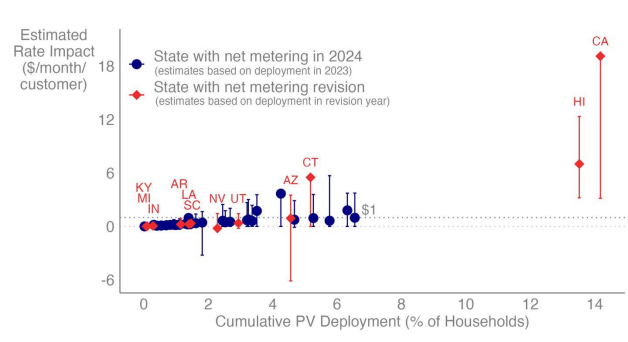
Image: NREL
In all 30 states with a solar deployment rate below 3% of households, net metering is unlikely to be associated with an increase in rates of more than $1 per month per customer without solar, the report said. Among states with a solar deployment rate between 3% and 7% of households, NREL estimated that each customer’s bills were impacted by less than $1 per month in two-thirds of the states, and from $2 to $6 per month in one-third of states.
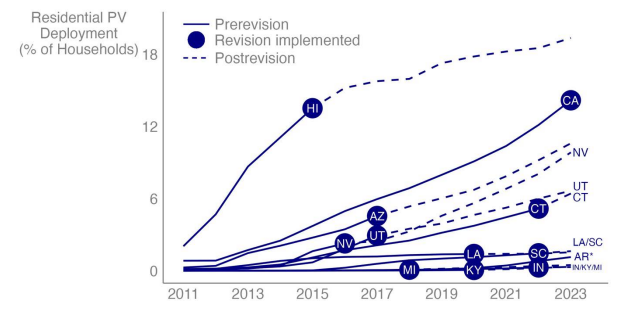
Image: NREL
NREL’s estimates exclude rooftop solar’s social and environmental impacts, “which do not directly affect electricity rates but could affect the perceived value of rooftop [solar] and of rate structures that enable its deployment.”
NREL said 12 states have replaced net metering with alternative rate structures that reduce solar adopter bill savings. Of these 12 states, nine did so when residential deployment was 3% or less. Additionally, NREL found that prior to its replacement, net metering likely only impacted each customer’s bill by less than $1 per month.
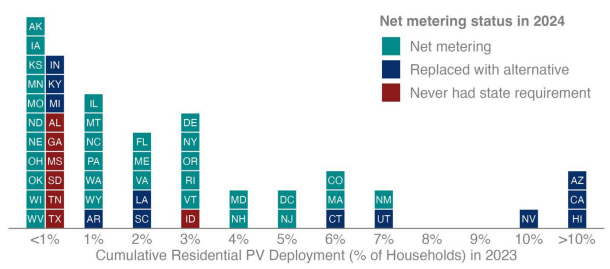
Image: NREL
NREL said rooftop solar’s impacts on utility cost recovery can be mitigated and managed through rate design that effectively forecasts solar adoption and the changing use patterns of solar adopters. However, in practice, NREL said, the under-recovery of forecasted revenues from solar adopters may cause rate designers to reallocate utility cost recovery among customer classes. Some stakeholders argue this reallocation of costs increases the rates of customers without solar, NREL said. These potential cost allocations are often called “cost shifts,” however, NREL chose not to use this term because “the under-recovery of revenues for costs allocated to PV adopters may or may not ultimately drive a cost shift in the sense that PV adopters do not pay for a service provided on their behalf.”
Net metering has been a key enabler of residential solar adoption in the U.S. because solar adopters realize long-term electricity bill savings, NREL said. Net metering is largely viewed as an administratively simple and acceptable default rate for residential solar adopters, NREL said.
“The timing and nature of net metering revisions are ultimately policy decisions based on balancing state-level priorities and considerations and the potential costs and benefits of different rate structures,” NREL said.
NREL said its qualitative methods did not account for rooftop solar’s broader social and environmental benefits because they do not affect electrical rates specifically. “Still, the estimated social and environmental benefits of rooftop [solar] can be substantial,” NREL said.
The study was funded by the U.S. Department of Energy.
Read about other research relevant to the solar industry here.
This content is protected by copyright and may not be reused. If you want to cooperate with us and would like to reuse some of our content, please contact: editors@pv-magazine.com.

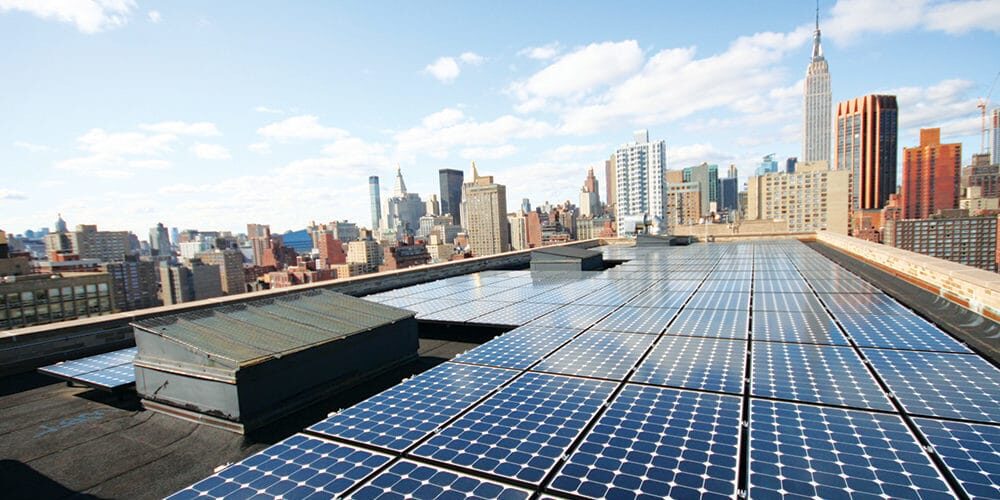


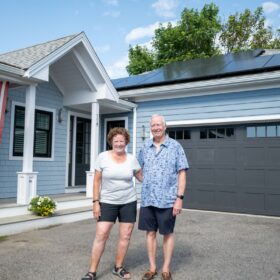


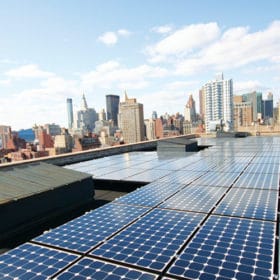
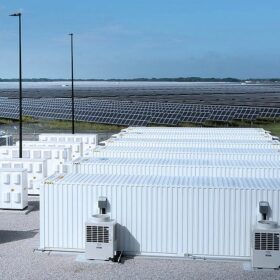
By submitting this form you agree to pv magazine using your data for the purposes of publishing your comment.
Your personal data will only be disclosed or otherwise transmitted to third parties for the purposes of spam filtering or if this is necessary for technical maintenance of the website. Any other transfer to third parties will not take place unless this is justified on the basis of applicable data protection regulations or if pv magazine is legally obliged to do so.
You may revoke this consent at any time with effect for the future, in which case your personal data will be deleted immediately. Otherwise, your data will be deleted if pv magazine has processed your request or the purpose of data storage is fulfilled.
Further information on data privacy can be found in our Data Protection Policy.